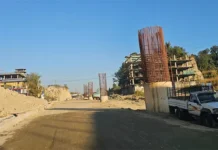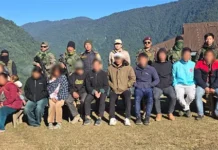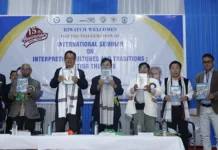[ Sailajananda Saikia ]
A largely forgotten rule from 1978 has sparked a heated cultural and theological discussion in the untamed, mist-shrouded hills of Arunachal Pradesh, which is home to 26 major tribes and over 100 sub-tribes whose ancient rites have persisted for millennia.
For 47 years, the Arunachal Pradesh Freedom of Religion Act (APFRA), which was passed when the state was a union territory, has not been put into effect. Now, in 2025, it has gained prominence due to the adamant demands of indigenous faith leaders rather than a government mandate, making it a crucial battlefield for religious freedom, tribal identity, and India’s secular values in one of its most diverse areas.
A legislative safeguard against coercion
The APFRA is one of the first state-level anti-conversion laws in India, having been passed on 24 October, 1978, and receiving presidential assent the next day. Its main goal is to use unethical methods to protect the tribal populations of Arunachal’s unique faiths and cultural heritage from outside religious influences.
The Act’s main provision includes:
Section 3: Prohibits conversion by coercion, deception, or seduction, including by providing gifts, jobs, or other advantages. Both adults and children are affected by this.
Section 4: Requires the deputy commissioner to be notified 15 days in advance of any conversion, after which its voluntary nature will be investigated. Within 30 days, a post-conversion report needs to be turned in.
Section 5: Penalties for forced conversions include up to two years in prison and a fine of Rs 10,000, while non-reporting carries a punishment of Rs 5,000 for a year.
Crucially, the Act allows voluntary changes in faith as long as they are unforced and fully documented; it does not completely forbid conversions. The Supreme Court’s 1977 decision in Rev Stanislaus vs State of Madhya Pradesh, which upheld that conversions accomplished by unethical means are not covered by Article 25’s fundamental freedom to spread religion, is consistent with this. But for more than 40 years, the APFRA was dormant without implementing regulations, which resulted in no formal notifications or prosecutions. It was merely a law in name until recent events gave it fresh vitality.
The groundswell of indigenous resistance
The pivotal moment came in September 2024 when the state government was ordered to draft implementation rules by 31 March, 2025, by the Gauhati High Court in response to a public interest litigation filed by advocate Tambo Tamin and backed by the Indigenous Faith and Cultural Society of Arunachal Pradesh (IFCSAP).
However, the movement was actually sparked by grassroots activism. More than 10,000 native inhabitants from all 27 districts assembled in Itanagar on 18 October, 2025, wearing traditional garb such as daos, hornbill plumes, and elaborate beaded necklaces. During traditional dances and Donyi-Polo prayer chants, they gave the stern warning, “Enforce APFRA now, or watch our culture die.”
An IFCSAP delegation met with Mama Natung, the home minister, three days later to demand prompt action. The mood was summed up by the society’s president, Dr Emi Rumi: “Our gods are not myths. Folklore is not what our rituals are. They are who we are. Is it faith or transaction if 90% of a village converts for roads and rice?
Changes in the population highlight these issues. According to census data, Christianity grew at the quickest rate in India, from roughly 0.8% in 1971 to 30.3% in 2011. Due in large part to missionary-provided help, healthcare, and education, Christian populations today make up between 80% and 90% of the population in areas like Tirap, Changlang, and Longding.
Christian communities push back
The Arunachal Christian Forum (ACF), which includes Presbyterian, Catholic, and Baptist organisations, has vigorously opposed the Act’s resuscitation.
Among the notable protests are: Over 7,000 people participated in an eight-hour hunger strike in Itanagar on 17 February, 2025. Followed by 1 March, 2025, when a large-scale demonstration demanded the repeal of the law.
A statewide human chain demonstration was scheduled on 6 March, 2025.
Prominent ACF leader. Rev James Techi Tara,expressed the community’s concerns: “The law is ambiguous. Is it ‘inducement’ to build a school? Is it ‘fraud’ to heal the sick?
Minorities are being harassed using this technology.
The March rally’s widely shared video, which declared Arunachal a ‘Christian state’, has increased indigenous concerns about demographic encroachment.
Government’s delicate balancing act
Pema Khandu, the chief minister of the Bharatiya Janata Party (BJP), is in a difficult situation. He said in February 2025: “APFRA does not attack any faith; it protects culture. The rules will be comprehensive. However, without finalised rules, the court’s deadline of 31 March passed. Drafts are still being reviewed as of 28 October, 2025; the ACF and the IFCSAP were consulted first. Former deputy commissioner Tabom Bam recalled: “In the 1990s, we used APFRA informally to reject licences for wholesale conversions. When used properly, it is effective.
Broader ramifications
The dispute goes much beyond the boundaries of Arunachal Pradesh.
Religious rights vs cultural preservation: The Act protects indigenous communities from erasure, but it also puts Christians at risk of evangelization and humanitarian efforts being suppressed.
National standards: Similar anti-conversion laws are currently in place in eleven states, and the verdict in Arunachal may have an impact on tribal territories covered by the Sixth Schedule, which is where local autonomy and national legal uniformity meet.
Secularism’s obstacles: The Supreme Court may step in to address concerns about whether state-specific religious laws violate the equality requirement of Article 14.
Possibility of unrest: Community disputes, the departure of Christian professionals, and international censure from organisations such as the US Commission on International Religious Freedom are among the dangers in the absence of concrete enforcement.
Looking forward
Arunachal must make important decisions as winter mists engulf the eastern Himalayas.
Balanced notification of rules: Preserves indigenous customs, permits monitoring voluntary conversions, and eases conflict. Dilution or delays could lead to court action and protests by the local population.
Repeal efforts: Could lead to political repercussions for the BJP in the Northeast and significant tribal rebellion.
A defining moment
The APFRA, which is older than many of the activists of today, is more than just a relic; it is a living force that has been moulded by young people organising for Donyi-Polo, priests under ancient banyans, and grandmothers wearing Nyishi shawls. It raises a crucial question for India’s democracy: Is it possible for the country to protect minorities’ beliefs without violating others’ rights? The bureaucracy in Itanagar and the judiciary in Delhi alone won’t provide the answer. It will reverberate from the hills, where ancestral spirits continue to whisper and the sun first reaches India. (The contributor is a professor in the geography department of RGU, Rono Hills)




